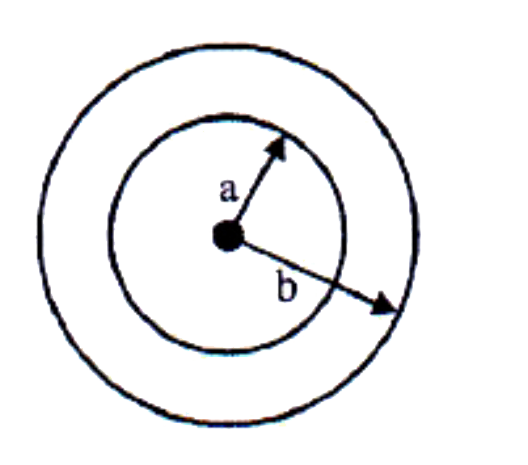Consider a sphere of radius R with harge density distributed as p(r)=kr fro r≤R=0 for r>R.
(a). Find the electric field as all points r.
(b) Suppose the total charge on the sphere is 2e where e is the electron charge. Where can two protons be embedded such that the force on each of them is zero. Assume that the introduction of the proton does not alter the negative charge distribution.
To solve the given problem, we will break it down into two parts as specified in the question.
Part (a): Finding the Electric Field at All Points r
1. Understanding Charge Density: The charge density is given as ρ(r)=kr for r≤R and ρ(r)=0 for r>R.
2. Using Gauss's Law: Gauss's Law states that:
ΦE=Qencϵ0
where ΦE is the electric flux through a closed surface and Qenc is the charge enclosed by that surface.
3. Case 1: r<R (Inside the sphere):
- The charge enclosed within a radius r is given by:
Qenc=∫r0ρ(r′)dV=∫r0kr′⋅4πr′2dr′=4πk∫r0r′3dr′=4πk(r′44)r0=πkr4
- The electric flux through a Gaussian surface of radius r is:
ΦE=E⋅4πr2
- Applying Gauss's Law:
E⋅4πr2=πkr4ϵ0
- Solving for E:
E=kr24ϵ0
4. Case 2: r>R (Outside the sphere):
- The total charge Q within the sphere is:
Q=∫R0ρ(r′)dV=∫R0kr′⋅4πr′2dr′=4πk(R44)=πkR4
- For r>R, the electric flux is:
ΦE=E⋅4πr2
- Applying Gauss's Law:
E⋅4πr2=πkR4ϵ0
- Solving for E:
E=kR44ϵ0r2
5. Final Results:
- For r<R:
E=kr24ϵ0
- For r>R:
E=kR44ϵ0r2
Part (b): Positioning Two Protons
1. Total Charge on the Sphere: The total charge on the sphere is given as 2e.
2. Placing Protons: We need to place two protons such that the net force on each is zero. Let the distance from the center of the sphere to each proton be d.
3. Forces Acting on Each Proton:
- Attractive Force due to the charge distribution:
F_{\text{attractive}} = qE = e \cdot \frac{k d^2}{4 \epsilon_0} \quad \text{(since d < R )}
- Repulsive Force due to the other proton:
Frepulsive=e24πϵ0(2d)2=e216πϵ0d2
4. Setting Forces Equal:
- For equilibrium:
Fattractive=Frepulsive
e⋅kd24ϵ0=e216πϵ0d2
- Rearranging gives:
kd4=e4π
5. Finding the Value of k:
- From the total charge Q=2e=πkR4:
k=2eπR4
- Substituting k into the force balance equation:
2eπR4d4=e4π
- Solving for d:
d4=R48⟹d=R√(4)8=R23/4=R20.75=R20.75
Final Answers:
- Electric Field:
- For r<R: E=kr24ϵ0
- For r>R: E=kR44ϵ0r2
- Distance from Center for Protons: d=R23/4
ΦE=Qencϵ0
where ΦE is the electric flux through a closed surface and Qenc is the charge enclosed by that surface.
- The charge enclosed within a radius r is given by:
Qenc=∫r0ρ(r′)dV=∫r0kr′⋅4πr′2dr′=4πk∫r0r′3dr′=4πk(r′44)r0=πkr4
- The electric flux through a Gaussian surface of radius r is:
ΦE=E⋅4πr2
- Applying Gauss's Law:
E⋅4πr2=πkr4ϵ0
- Solving for E:
E=kr24ϵ0
- The total charge Q within the sphere is:
Q=∫R0ρ(r′)dV=∫R0kr′⋅4πr′2dr′=4πk(R44)=πkR4
- For r>R, the electric flux is:
ΦE=E⋅4πr2
- Applying Gauss's Law:
E⋅4πr2=πkR4ϵ0
- Solving for E:
E=kR44ϵ0r2
- For r<R:
E=kr24ϵ0
- For r>R:
E=kR44ϵ0r2
- Attractive Force due to the charge distribution:
F_{\text{attractive}} = qE = e \cdot \frac{k d^2}{4 \epsilon_0} \quad \text{(since d < R )}
- Repulsive Force due to the other proton:
Frepulsive=e24πϵ0(2d)2=e216πϵ0d2
- For equilibrium:
Fattractive=Frepulsive
e⋅kd24ϵ0=e216πϵ0d2
- Rearranging gives:
kd4=e4π
- From the total charge Q=2e=πkR4:
k=2eπR4
- Substituting k into the force balance equation:
2eπR4d4=e4π
- Solving for d:
d4=R48⟹d=R√(4)8=R23/4=R20.75=R20.75
- Electric Field:
- For r<R: E=kr24ϵ0
- For r>R: E=kR44ϵ0r2
- Distance from Center for Protons: d=R23/4
Topper's Solved these Questions
- ELECTRIC CHARGES AND FIELDBOOK - NCERT EXEMPLAR ENGLISHCHAPTER - ELECTRIC CHARGES AND FIELDEXERCISE - Short Answer Type question
6 Videos
- DUAL NATURE OF RADIATION AND MATTERBOOK - NCERT EXEMPLAR ENGLISHCHAPTER - DUAL NATURE OF RADIATION AND MATTEREXERCISE - LONG ANSWER TYPE QUESTION
5 Videos
- ELECTROMAGNETIC INDUCTION BOOK - NCERT EXEMPLAR ENGLISHCHAPTER - ELECTROMAGNETIC INDUCTION EXERCISE - Long
11 Videos
Similar Questions
A solid ball of radius R has a charge density ρ given by ρ=ρ0(1−rR)for0≤r≤R The electric field outside the ball is :
View SolutionCharge is distributed within a sphere of radius R with a volume charge density p(r)=Ar2e−2r/a, where A and a are constants. If Q is the total charge of this charge distribution, the radius R is :
View Solution
Knowledge Check
There is a solid sphere of radius R having uniformly distributed charge throughout it. What is the relation between electric field E and distance r from the centre (r is less than R) ?
AE∝r−2BE∝r−1CE∝rDE∝r2Let ρ(r)=QrπR4 be the charge density distribution for a soild sphere of radius R and total charge Q. For a point P inside the sphere at a distance r1 from the centre of the sphere, the magnitude of electric field is
AQr214πε0R4BQr213πε0R4C0DQ4iε0r21
A charge +Q, is uniformaly distributed within a sphere of radius R. Find the electric field, due to this charge distribution, at a point distant r form the centre of the spehre where :
(i) 0<r<R and
(ii)r>R
View SolutionAn uncharged metallic solid sphere of radius R is placed at a distance 2R from point charge Q as shown in figure. The electric field intensity due to induced charge at centre of sphere is
View SolutionA conducting sphere of radius R is charged to a potential of V volts. Then the electric field at a distance r(>R) from the centre of the sphere would be
View SolutionThe electric field at a distance 3R/2 from the centre of a charge conducting spherical shell of radius R is E. The electric field at a distance R/2 from the centre of the sphere is
View SolutionThe electric field at a distance 3R/2 from the centre of a charge conducting spherical shell of radius R is E. The electric field at a distance R/2 from the centre of the sphere is
View SolutionIn a spherical distribution , the charge density varies as ρ(r)=A/r for a<r<b (as shown) where A is constant . A point charge Q lies at the centre of the sphere at r = 0 . The electric filed in the region a<r<b has a constant magnitude for

View Solution
